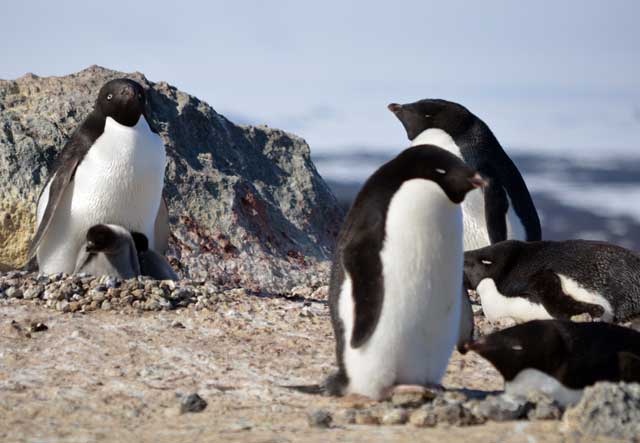A weighty problemScientists find link between weather conditions and mass of Adélie penguin chicksPosted November 13, 2014
Researchers recently reported a connection between local weather conditions and the weight of Adélie penguin chicks in an article in Marine Ecology Progress Series, a top marine ecology journal. The study involved Adélie penguins living along the western side of the Antarctic Peninsula, one of the most rapidly warming areas on Earth. Since 1950, the average annual temperature in the Antarctic Peninsula has increased about three degrees Celsius on average, and six degrees Celsius during winter. As the climate warms, it is changing from a dry, polar system to a warmer, sub-polar system with more rain. Penguin chick weight at the time of fledging, when they leave the nest, is considered an important indicator of food availability, parental care and environmental conditions at a penguin colony. A higher chick mass provides the chick a better likelihood of surviving and propagating the species. In the study, Megan Cimino, a University of Delaware doctoral student and the paper’s lead author, compared data from 1987 to 2011 related to the penguin’s diet, the weather and the large-scale climate indices to see if they could correlate year-to-year penguin chick weight with a particular factor. She also evaluated samples from the penguin’s diet to determine what they were eating. “The ability of a penguin species to progress is dependent on the adults’ investment in their chicks,” said Matthew Oliver, an associate professor of marine science and policy and principal investigator on the project. “Penguins do a remarkable job of finding food for their chicks in the ocean’s dynamic environment, so we thought that the type and size distribution of food sources would impact chick weight.” Instead, the study revealed that weather and overall climate seemed to affect weights the most. In particular, local weather – including high winds, cold temperatures and precipitation – had the largest impact on penguin chick weight variations over time. “It’s likely that weather variations are increasing the chicks’ thermoregulatory costs; and when they are cold and wet, they have to expend more energy to keep warm,” Cimino said. The wind can also affect the marine environment, she added, mixing up the water column and dispersing krill, a small shrimp-like crustacean that serves as a main food source. That may cause parent penguins to remain at sea for longer periods of time and cause chicks to be fed less frequently. “This is an interesting study, because it calls into question what happens to an ecosystem when you change climate quickly: Is it just large-scale averages that change the ecosystem or do particular daily interactions also contribute to the change,” Oliver said. Photo Credit: Jeffrey Kietzmann/ Antarctic Photo Library
A colony of Adélie penguins on Humble Island near the Antarctic Peninsula.
Other co-authors on the paper include William Fraser and Donna Patterson-Fraser, from the Polar Oceans Research Group, and Vincent Saba, from NOAA National Marine Fisheries Service. Fraser and Patterson have been collecting data on Adélie penguins since the late 1970s, creating a strong fundamental dataset that includes statistics collected over decades, even before rapid warming was observed. By correlating the relevant environmental variables through analysis of data from sources such as weather station and satellites, the researchers were able to validate a potential cause for chick weight variation over time. Using big data analyses to sift through the possible causes allowed the researchers to take a forensic approach to understanding the problem. “Climate change strikes at the weak point in the cycle or life history for each different species,” Oliver said. “The Adélie penguin is incredibly adaptive to the marine environment, but climate ends up wreaking havoc on the terrestrial element of the species’ history, an important lesson for thinking about how we, even other species, are connected to the environment.” Cimino will return to Antarctica in November 2014 to begin working with physical oceanographers from University of Alaska and Rutgers University, through funding from the National Science Foundation. Using robotics, she will investigate what parent penguins actually do in the ocean in order to gain a broader perspective on how the penguins use the marine environment. In particular, she hopes to explore other possible contributing factors to chick weight variation such as parental foraging components that were not part of this study. “It’s important for us to understand what’s going on, especially as conditions are getting warmer and wetter, because it may give us an idea of what may happen to these penguins in the future,” Cimino said. For more information, see the University of Delaware press release National Science Foundation-funded research in this article included grants 8918324, 9011927, 9103429, 9320115, 9505596, 9632763, 9910095, 0130525, 0217282, 0224727, 0523261, 0741351, 0823101. |



For USAP Participants |
For The Public |
For Researchers and EducatorsContact UsNational Science FoundationOffice of Polar Programs Geosciences Directorate 2415 Eisenhower Avenue, Suite W7100 Alexandria, VA 22314 Sign up for the NSF Office of Polar Programs newsletter and events. Feedback Form |


